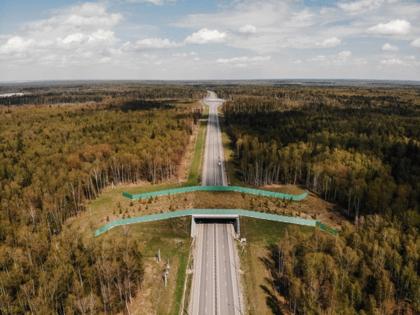Wildlife corridors decrease animal-vehicle crashes by up to 97%. So where are they?
Published in Outdoors
PITTSBURGH — Black bears, deer, bobcats and other wildlife used to cross Route 220 in the forests near State College, sometimes to their detriment and that of motorists.
When the I-99 extension replaced that section of Route 220 with five wildlife underpasses, animal and car collisions dropped from nine animal deaths in 2009 to one in 2010, when the project was completed.
It was among 35 wildlife crossing projects included in a recent report, "Wildlife Corridors: How reconnecting habitats is protecting Pennsylvania's native species."
Published by the PennEnvironment Research & Policy Center in Philadelphia, the nonprofit's report calls for greater coordination among government agencies, nonprofits and others to provide more corridors.
Engineered wildlife crossings combined with fencing and other features can reduce wildlife-vehicle collisions by 97%, according to research cited in the report.
Protecting animals trying to cross a busy road, these safer routes link fragmented habitats and allow native species to move, migrate, forage and mate.
Motorists rarely see these wildlife corridors. In Pennsylvania, they are typically underpasses and enhanced water culverts that are part of road projects, according to the report.
While transportation and environmental officials know the crossings prevent collisions, connecting the dots isn't so easy.
"While many of our state agencies and commissions are already independently pursuing conservation goals, including habitat connectivity, there isn't yet a statewide habitat connectivity plan or list of priority wildlife crossings to drive a common interagency agenda," said Stephanie Wein, the report's author and a water and conservation advocate for PennEnvironment.
Evaluating road projects for wildlife crossings is a PennDOT requirement, said agency press secretary Alexis Campbell. But PennDOT doesn't have to install the crossings.
So who pays for the projects?
Funding can and has come from various sources, including nonprofits, state wildlife agencies and the state budget, Wein said.
Depending on size, costs vary from hundreds of thousands to millions of dollars. Amphibian crossings can be relatively inexpensive, but costs increase as structures get larger, Wein said.
These costs can be justified based on reducing animal-vehicle collisions and increased safety for motorists.
The cost per deer-vehicle crash is estimated at $9,200 for medical bills, property damage and other expenses, according to the state.
Pennsylvania has the dubious distinction of having the most automobile and wildlife crashes in the country. The state topped the nation with more than 150,000 claims filed as the result of animal collisions from July 1, 2023, to June 30, 2024, according to State Farm.
Engineered wildlife crossings are rare in the Pittsburgh region.
There is an amphibian crossing in Fayette County, and four amphibian and one large mammal crossings in Somerset County on the Route 219 Meyersdale Bypass, according to PennDOT.
Another wildlife crossing is in the works for the Meyersdale Bypass to the Maryland state line, Wein said.
PennDOT doesn't have any plans currently for an Allegheny County wildlife crossing, she added.
The approach to corridors is targeted — matching areas with the most vehicle-wildlife crashes and routes used frequently by wildlife.
Not every location is a good candidate for a crossing, Wein said, but other things can be done such as exclusionary fences and warning devices.
So far, wildlife corridors have political appeal in Pennsylvania.
The state House's Legislative Budget and Finance Committee released a set of recommendations in 2024, including identifying and protecting high-priority wildlife crossing areas, tracking and coordinating more wildlife and vehicle collisions, and increasing what the state Game Commission can spend to buy land for conservation.
Plans are underway, Wein said — the Federal Highway Administration has awarded $840,000 to PennDOT for a Wildlife Crossing Pilot Program to develop a statewide wildlife crossing plan.
____
© 2025 the Pittsburgh Post-Gazette. Visit www.post-gazette.com. Distributed by Tribune Content Agency, LLC.







Comments